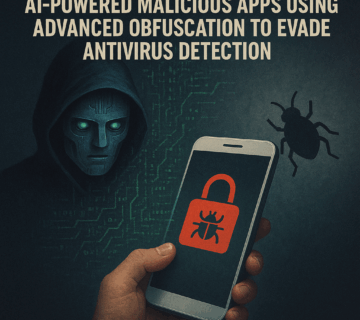Malicious AI-Generated Ransomware Extension Infiltrates Microsoft’s VS Code Marketplace
🎙️ Dive Deeper with Our Podcast!
AI Ransomware Infiltrates VS Code Marketplace
The developer community faced a wake-up call this week when security researchers discovered a ransomware-equipped extension hiding in plain sight on Microsoft’s official Visual Studio Code marketplace. The incident highlights growing concerns about AI-assisted malware development and the challenges of vetting third-party code in popular development environments.
A Brazen Attack Hidden in Plain Sight
Security analyst John Tuckner from Secure Annex uncovered an extension named “susvsex” published under the account “suspublisher18” that didn’t even attempt to hide its malicious intentions. The extension’s description openly disclosed its capabilities: stealing files to a remote server and encrypting all user data using AES-256-CBC encryption.
What makes this discovery particularly alarming isn’t just the malware itself, but Microsoft’s initial response. Despite Tuckner filing a detailed report explaining the extension’s explicit threat disclosure, the tech giant initially ignored the warning and left the dangerous code available for download. The extension remained accessible on the marketplace until media attention forced its removal.
The Mechanics Behind This AI-Assisted Threat
The malicious extension operates through a surprisingly straightforward attack chain. Upon installation or whenever VS Code launches, the extension activates and initializes an ‘extension.js’ file containing hardcoded variables including IP addresses, encryption keys, and command-and-control server locations.
Tuckner’s analysis revealed telltale signs of AI-generated code throughout the extension. Comments embedded within the code suggested the publisher didn’t write it directly but instead relied on AI tools to generate the malicious functionality—a practice researchers have dubbed “vibe coding.”
Once activated, the extension executes a function called zipUploadAndEncrypt. This routine first checks for a marker file, then systematically creates ZIP archives of files in targeted directories. These archives get exfiltrated to the attacker’s command-and-control server before the original files are replaced with encrypted versions, rendering them inaccessible to the victim.
Command-and-Control Through GitHub
The attack demonstrated a creative abuse of legitimate platforms. The extension periodically polls a private GitHub repository, checking an ‘index.html’ file for new commands. Authentication happens through a Personal Access Token (PAT) hardcoded into the extension.
By leveraging this exposed PAT, Tuckner accessed the repository and gathered host information, tracing the likely origin of the attack to Azerbaijan. This GitHub-based command structure would have allowed the attacker to remotely control infected systems and potentially expand the malware’s capabilities after deployment.
The Growing Threat of AI-Generated Malware
Security experts classify this extension as “AI slop“—rudimentary malicious code generated through AI tools with minimal sophistication. While this particular threat openly advertised its malicious behavior in the README file, researchers warn that minor modifications could transform similar code into far more dangerous weapons.
The incident raises serious questions about the future of software supply chain security. AI tools have lowered the barrier to entry for malware development, enabling threat actors with limited coding expertise to create functional attacks. As these AI systems become more advanced, the quality and stealth of automatically generated malware will likely improve.
Testing Microsoft’s Security Vetting Process?
Given the extension’s overtly malicious description and its crude implementation, some security researchers believe this may have been a deliberate test of Microsoft’s marketplace security controls. The fact that explicitly described ransomware functionality remained available despite direct reporting suggests significant gaps in the vetting process for VS Code extensions.
This vulnerability in Microsoft’s review system creates serious risks for the millions of developers who rely on VS Code extensions to enhance their productivity. A more sophisticated attacker could easily exploit these same weaknesses while better concealing malicious behavior.
Implications for Development Teams
This incident serves as a critical reminder that even official marketplaces from trusted vendors can harbor threats. Development teams need to approach third-party extensions with the same caution they apply to any untrusted code:
First, always review extension permissions before installation. Extensions requesting broad file system access or network capabilities deserve extra scrutiny. Second, check publisher reputation and extension reviews. New publishers with minimal download counts should raise red flags. Third, examine the extension’s source code when possible, particularly for extensions from unknown developers.
Organizations should also implement policies requiring security review of all development tools and extensions before deployment across their environment. What might seem like a productivity enhancement could become an entry point for data theft or ransomware attacks.
FAQ
What is the susvsex extension and why is it dangerous?
The susvsex extension is a malicious VS Code extension that contains ransomware functionality. Once installed, it automatically encrypts files on the victim’s system using AES-256-CBC encryption and exfiltrates data to a remote server controlled by attackers. The extension operated through Microsoft’s official marketplace, making it appear legitimate to unsuspecting developers.
How can I tell if a VS Code extension is safe to install?
Check several factors before installing any extension: verify the publisher’s reputation and history, read user reviews carefully, examine the number of downloads (be cautious of extensions with very few installs), review the permissions requested by the extension, and when possible, inspect the source code. Extensions requesting extensive file system access or network permissions warrant extra scrutiny.
Was this ransomware created entirely by artificial intelligence?
Based on security analysis, the code shows clear signs of AI-generation through comments and coding patterns that suggest the creator used AI tools to write the malicious functionality. However, a human attacker still directed the AI and published the extension. This represents a growing trend where threat actors leverage AI to lower the technical barriers to creating malware.
Did Microsoft remove the malicious extension from their marketplace?
Yes, though not immediately. Despite security researchers reporting the extension with detailed explanations of its malicious capabilities, Microsoft initially failed to remove it. The extension was only taken down after the incident gained media attention, raising concerns about the effectiveness of Microsoft’s marketplace security vetting processes.
How common are malicious extensions in development environment marketplaces?
While relatively rare compared to the total number of available extensions, malicious extensions do periodically appear in official marketplaces. The challenge lies in balancing ease of publishing for legitimate developers against the need for thorough security screening. This incident highlights the ongoing cat-and-mouse game between security teams and malicious actors.
What should I do if I’ve already installed this extension?
If you installed the susvsex extension, immediately disconnect your system from the network, uninstall the extension, run a complete malware scan using updated security software, and check for any encrypted files or suspicious network activity. Consider restoring affected files from clean backups and changing any credentials that may have been exposed. Contact your IT security team for additional guidance on incident response.
Can organizations protect themselves from supply chain attacks through extensions?
Yes, through multiple layers of defense. Organizations should implement policies requiring approval before installing development tools or extensions, maintain an approved list of vetted extensions, use endpoint detection and response (EDR) solutions to monitor for suspicious behavior, regularly audit installed extensions across the development team, and provide security training to developers about supply chain risks.
How Technijian Can Help
The discovery of malicious code in Microsoft’s VS Code marketplace underscores a fundamental challenge facing modern businesses: the software supply chain has become a primary attack vector that traditional security tools often miss. At Technijian, we understand that protecting your development environment requires more than basic antivirus software—it demands comprehensive security strategies tailored to the complex threats facing Orange County businesses today.
Our managed cybersecurity services provide multi-layered protection for your development teams and entire IT infrastructure. We implement endpoint detection and response solutions that monitor for suspicious behavior patterns, catching threats that slip through marketplace vetting processes. Our security experts work with your team to establish policies for vetting third-party tools and extensions before they’re deployed across your environment.
Beyond reactive security, Technijian offers proactive security assessments that identify vulnerabilities in your software development lifecycle. We help establish secure coding practices, implement access controls that limit the damage from compromised tools, and create incident response plans specifically designed for supply chain attacks. Our team stays current with emerging threats like AI-generated malware, ensuring your defenses evolve as quickly as the threat landscape.
For businesses concerned about ransomware protection, our immutable backup solutions ensure that even if malicious code encrypts your files, you can recover quickly without paying ransom. We implement Microsoft 365 security configurations that provide additional layers of defense for cloud-based development workflows, and our 24/7 monitoring catches suspicious activity before it escalates into a full-scale breach.
Don’t wait for a security incident to expose gaps in your development environment protection. Contact Technijian today for a comprehensive security assessment. Our team of cybersecurity experts serves businesses throughout Irvine and Southern California with solutions designed to protect against both current threats and emerging risks. Let us help you build a security framework that enables your developers to work productively while keeping your intellectual property and sensitive data safe from supply chain attacks.
About Technijian
Technijian is a premier Managed IT Services provider in Irvine, specializing in delivering secure, scalable, and innovative AI and technology solutions across Orange County and Southern California. Founded in 2000 by Ravi Jain, what started as a one-man IT shop has evolved into a trusted technology partner with teams of engineers, AI specialists, and cybersecurity professionals both in the U.S. and internationally.
Headquartered in Irvine, we provide comprehensive cybersecurity solutions, IT support, AI implementation services, and cloud services throughout Orange County—from Aliso Viejo, Anaheim, Costa Mesa, and Fountain Valley to Newport Beach, Santa Ana, Tustin, and beyond. Our extensive experience with enterprise security deployments, combined with our deep understanding of local business needs, makes us the ideal partner for organizations seeking to implement security solutions that provide real protection.
We work closely with clients across diverse industries including healthcare, finance, law, retail, and professional services to design security strategies that reduce risk, enhance productivity, and maintain the highest protection standards. Our Irvine-based office remains our primary hub, delivering the personalized service and responsive support that businesses across Orange County have relied on for over two decades.
With expertise spanning cybersecurity, managed IT services, AI implementation, consulting, and cloud solutions, Technijian has become the go-to partner for small to medium businesses seeking reliable technology infrastructure and comprehensive security capabilities. Whether you need Cisco Umbrella deployment in Irvine, DNS security implementation in Santa Ana, or phishing prevention consulting in Anaheim, we deliver technology solutions that align with your business goals and security requirements.
Partner with Technijian and experience the difference of a local IT company that combines global security expertise with community-driven service. Our mission is to help businesses across Irvine, Orange County, and Southern California harness the power of advanced cybersecurity to stay protected, efficient, and competitive in today’s threat-filled digital world.





